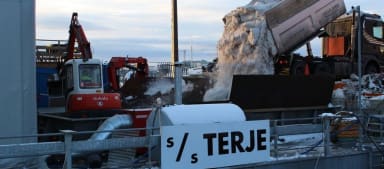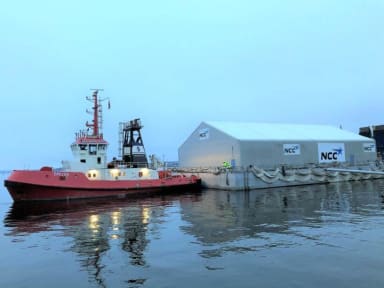NCC SnowClean
NCC’s snow melting system can resolve challenges faced by municipalities, maintainers of public roads and anyone else who has no alternative to the current depositing of snow, with its impact on the environment.
NCC has developed a snow melting system that resolves the depositing problems faced by coastal towns in an efficient, eco-friendly way. The system melts the snow using energy extracted from the temperature of seawater. The water is treated during and after the melting process to remove all contaminants such as solid particles, oil residues and heavy metal. The system may also result in considerable reduction of the need for transport, as is the case when snow is deposited.
This snow melting system won the Federation of Norwegian Construction Industries’ innovation award in 2013 during the Bygg Reis Deg trade fair.
No more contaminated snow in Oslo
NCC and the municipality of Oslo has concluded an agreement which means that NCC will receive all the snow removed from the roads and streets of Oslo. The snow will be transported to NCC’s snow melting plant, where it will be treated and melted. The treated meltwater will then be fed out into the Oslofjord.
Chief engineer Terje Myrhaug of NCC came up with the idea of the snow melting system and has been responsible for the entire development process.
“We have succeeded in developing a solution that will eliminate the need for snow landfills in Oslo. This solution will also have positive environmental effects”, says Myrhaug. NCC’s environmental accounts show that the reduction in CO2 is equivalent to the annual emissions generated by 270 cars.
“For the people of Oslo, our solution means cleaner air, cleaner groundwater and a cleaner harbor basin. We will also eliminate the visual contamination of landfill sites. This is why we believe our solution will also be of great interest to a number of large towns and cities in northern Europe”, says Myrhaug.
Snow removal innovation

The “Terje” snow melting system docked in December 2011. The system uses a specially constructed barge for melting snow using seawater. The system consists of two courses. Snow is tipped down onto intake grilles on the deck of the barge and then mixed with seawater pumped in from a depth of 23 m. The snow is then propelled by gravity through the system with the assistance of a propeller early on in the process and agitators fitted with “wings”.
The snow normally melts very quickly after being crushed initially in the process. Sedimentation of the particulates then takes place with the assistance of various treatment stages through the system, including screens, fin separators and microfilters. Finally, the treated meltwater is released underneath the barge and into the harbor basin.
The barge is surrounded by a silt skirt which slows the flow of particulates from the system and promotes faster sedimentation over a smaller area. The plan with the system is to continue devising increasingly effective ways of treating the snow efficiently. Addition of chemical flocculants to the existing system is not considered relevant as this is not designed for the conditions demanded by such agents.
The system turned out to be capable of handling significant volumes of snow for longer periods and removing a significant proportion of contaminants so that these can be disposed of properly, and possibly recycled. The emissions limits have been exceeded at times. Nevertheless, the system has generally demonstrated improvement season on season, and the intention is to continue with this process. The snow melting system is designed to be able to treat up to 500,000 – 600,000 m3 of snow every winter, at a rate of 500 – 700 m3 per hour. So the trial period has not offered any load higher than approximately one-fifth of capacity for an entire season. However, the melting capacity – given the amount of snow per hour – has been exceeded on a number of occasions with no discernible problems.
This is very clearly a new way of dealing with snow in towns, with a clear eco-friendly effect.

